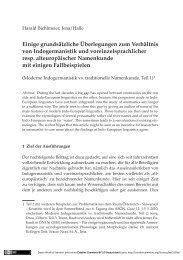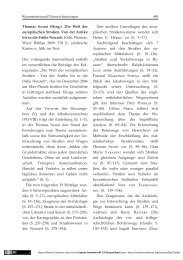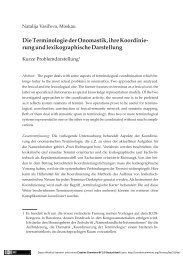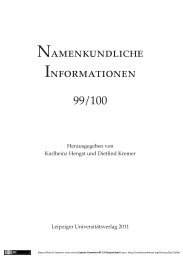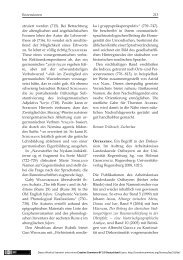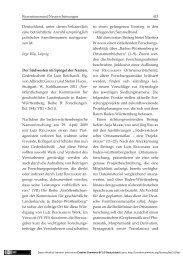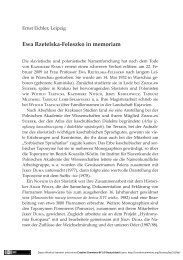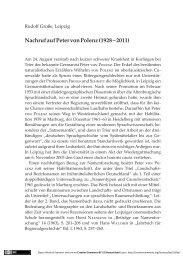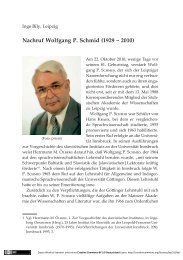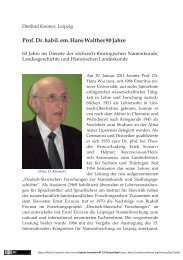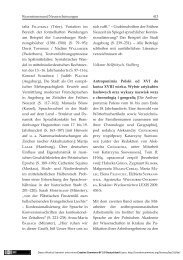Proper Names in the Light of Theoretical Onomastics
Proper Names in the Light of Theoretical Onomastics
Proper Names in the Light of Theoretical Onomastics
You also want an ePaper? Increase the reach of your titles
YUMPU automatically turns print PDFs into web optimized ePapers that Google loves.
<strong>Proper</strong> <strong>Names</strong> In <strong>the</strong> <strong>Light</strong> <strong>of</strong> <strong>Theoretical</strong> <strong>Onomastics</strong>127proprial nom<strong>in</strong>ation and structural organisation <strong>of</strong> onymic systems, specificallyonymic elements (e. g. onymic semantics, reflections <strong>of</strong> ono semes<strong>in</strong> language form, nam<strong>in</strong>g models, functional components <strong>in</strong> personalnam<strong>in</strong>g) are characteristic. In research <strong>in</strong>to <strong>the</strong> extensive problems <strong>of</strong> <strong>the</strong>verbal communication <strong>of</strong> proper names, not only <strong>the</strong>ir l<strong>in</strong>guistic but also<strong>the</strong>ir onomastic status must be taken <strong>in</strong>to consideration (Šrámek 2003).The components <strong>of</strong> an onymic system function as dynamic values with<strong>in</strong><strong>the</strong> given social standards <strong>in</strong> <strong>the</strong> contact <strong>of</strong> l<strong>in</strong>gual and extra-l<strong>in</strong>gualprocesses and <strong>in</strong> certa<strong>in</strong> dimensions <strong>of</strong> time, space and frequency. Let usfocus on several examples, ma<strong>in</strong>ly <strong>of</strong> personal nam<strong>in</strong>g, to demonstratehow onymy acts <strong>in</strong> close relation with <strong>the</strong> nam<strong>in</strong>g system.In <strong>the</strong> codified standards for personal nam<strong>in</strong>g <strong>in</strong> Slovakia, <strong>the</strong> b<strong>in</strong>arynam<strong>in</strong>g system <strong>of</strong> <strong>the</strong> a + B type, is used, i. e. comb<strong>in</strong><strong>in</strong>g two functionalcomponents - Christian name and surname. In previous texts, I haveshown that <strong>the</strong> functional components represent certa<strong>in</strong> onymic values(with a given onymic designation). This is <strong>the</strong> core <strong>of</strong> <strong>the</strong> <strong>of</strong>ficial system(<strong>the</strong> marg<strong>in</strong>al components can be ignored). The hierarchically basicfunctional component is <strong>the</strong> surname due to its anthroponymic features〈family affiliations with<strong>in</strong> a family as a whole〉 and 〈heredity〉 which <strong>in</strong><strong>the</strong> Christian name applies <strong>in</strong> a negative sense. The common features <strong>of</strong><strong>the</strong>se two functional components are 〈natural genre〉, 〈stabilisation byadm<strong>in</strong>istrative and legal standards〉, 〈validity from birth〉. So, <strong>the</strong> componentsdiffer <strong>in</strong> <strong>the</strong>ir onymic validity. Also, <strong>the</strong> nam<strong>in</strong>g <strong>of</strong> married womenand children is <strong>in</strong>cluded <strong>in</strong> <strong>the</strong> <strong>of</strong>ficial standards. The <strong>of</strong>ficially obligatoryform is <strong>the</strong> form <strong>of</strong> <strong>the</strong> surname which is recorded <strong>in</strong> a register <strong>of</strong> births.The registers <strong>of</strong> births utilise an <strong>of</strong>ficial <strong>in</strong>ventory <strong>of</strong> Christian nameswhich, as far as current social requirements are concerned, is not completelyclosed. These nam<strong>in</strong>g standards are realised <strong>in</strong> a nam<strong>in</strong>g scheme:Christian names (Adam, … , Eva, …) + surname (Hlavaj, Hlavajová…, (Maximilián)Nitra, (Anna) Nitrová…). In ord<strong>in</strong>ary communication, <strong>the</strong> Christiannames have various hypocoristic forms (dialect usage differs substantially<strong>in</strong> many aspects); <strong>the</strong> surname form is standardised. Un<strong>of</strong>ficial per sonalnam<strong>in</strong>g <strong>in</strong> Slovakia is much more varied. Nam<strong>in</strong>g standards <strong>of</strong> liv<strong>in</strong>gnames orig<strong>in</strong>ate <strong>in</strong> local and regional conventions which relate to <strong>the</strong> construction<strong>of</strong> functional components, <strong>the</strong>ir number, area distribution andalso to some nam<strong>in</strong>g pr<strong>in</strong>ciples (for detailed description and analysis:Blanár / Matejčík 1978/ 1983). The homonymic surname Nitra fulfils itsidentify<strong>in</strong>g role when an addressee (<strong>the</strong> addressed person, speaker, read-



